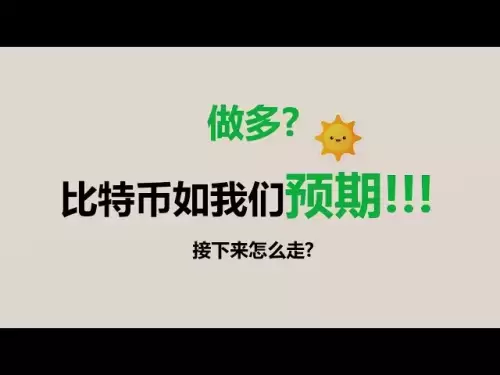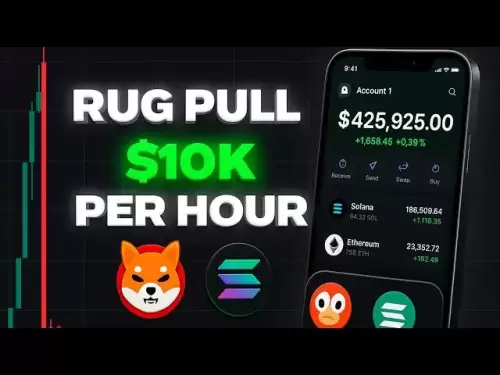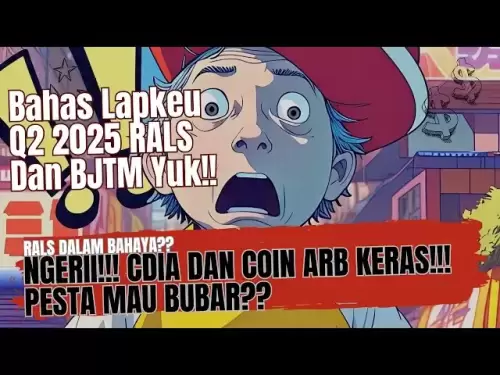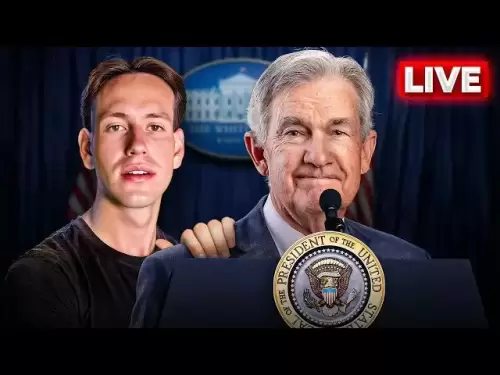-
 Bitcoin
Bitcoin $118400
0.47% -
 Ethereum
Ethereum $3836
2.20% -
 XRP
XRP $3.157
2.98% -
 Tether USDt
Tether USDt $0.9999
-0.03% -
 BNB
BNB $801.5
1.31% -
 Solana
Solana $180.9
2.07% -
 USDC
USDC $0.9999
-0.02% -
 Dogecoin
Dogecoin $0.2225
2.50% -
 TRON
TRON $0.3285
-1.02% -
 Cardano
Cardano $0.7789
2.60% -
 Hyperliquid
Hyperliquid $43.60
2.39% -
 Sui
Sui $3.892
4.41% -
 Stellar
Stellar $0.4229
3.34% -
 Chainlink
Chainlink $18.01
3.98% -
 Hedera
Hedera $0.2745
6.77% -
 Bitcoin Cash
Bitcoin Cash $582.3
3.38% -
 Avalanche
Avalanche $23.77
1.04% -
 Ethena USDe
Ethena USDe $1.001
0.01% -
 Toncoin
Toncoin $3.493
3.59% -
 Litecoin
Litecoin $110.0
2.48% -
 UNUS SED LEO
UNUS SED LEO $8.936
-0.37% -
 Shiba Inu
Shiba Inu $0.00001304
2.49% -
 Uniswap
Uniswap $9.999
1.09% -
 Polkadot
Polkadot $3.897
3.26% -
 Monero
Monero $308.6
-0.83% -
 Dai
Dai $0.9999
-0.01% -
 Bitget Token
Bitget Token $4.504
-0.04% -
 Pepe
Pepe $0.00001154
2.95% -
 Cronos
Cronos $0.1471
3.06% -
 Ethena
Ethena $0.6691
19.53%
How does a blockchain node achieve capacity expansion? How does it support high throughput?
Blockchain nodes achieve capacity expansion through sharding, Layer 2 solutions, and larger block sizes, supporting high throughput with optimized performance and efficient consensus mechanisms.
May 16, 2025 at 05:01 am

How does a blockchain node achieve capacity expansion? How does it support high throughput?
Blockchain technology has revolutionized the way we think about digital transactions and data management. At the core of any blockchain network are nodes, which are essentially computers that maintain the integrity and functionality of the blockchain. As the demand for blockchain services grows, the need for capacity expansion and high throughput becomes crucial. This article delves into how a blockchain node achieves capacity expansion and supports high throughput, providing a comprehensive understanding of the mechanisms involved.
Understanding Blockchain Nodes and Their Role
Blockchain nodes are the backbone of any blockchain network. They store, validate, and propagate transactions and blocks across the network. There are different types of nodes, such as full nodes, which store the entire blockchain, and light nodes, which store only a subset of the data. The performance and scalability of a blockchain largely depend on the efficiency and capacity of these nodes.
Methods for Achieving Capacity Expansion
Capacity expansion in blockchain nodes can be achieved through several methods. Each method aims to increase the node's ability to handle more data and transactions without compromising the network's integrity.
Sharding
Sharding is a technique where the blockchain is divided into smaller pieces, called shards. Each shard contains its own subset of the network's data and transactions. By distributing the workload across multiple shards, nodes can process transactions more efficiently.
- Implementing Sharding: To implement sharding, developers need to modify the blockchain protocol to support the creation and management of shards. This involves:
- Designing a sharding algorithm to distribute data evenly.
- Ensuring that each shard can communicate with other shards to maintain network consensus.
- Implementing cross-shard transactions to allow transactions that span multiple shards.
Layer 2 Scaling Solutions
Layer 2 scaling solutions operate on top of the main blockchain (Layer 1) and help offload the transaction processing from the main chain. Examples include the Lightning Network for Bitcoin and Plasma for Ethereum.
- Using Layer 2 Solutions: To use Layer 2 solutions, users typically:
- Set up a wallet compatible with the Layer 2 protocol.
- Open a channel or a sidechain to conduct off-chain transactions.
- Close the channel or sidechain to settle transactions on the main blockchain.
Increasing Block Size
Increasing block size is another straightforward method to expand capacity. Larger blocks can contain more transactions, thus increasing the throughput of the network.
- Adjusting Block Size: To increase block size, a blockchain's protocol must be updated. This usually requires:
- Proposing a hard fork to change the block size limit.
- Gaining consensus among the network participants.
- Implementing the new block size limit across the network.
Supporting High Throughput
High throughput is essential for a blockchain to handle a large volume of transactions efficiently. Several techniques are employed to ensure nodes can support high throughput.
Optimizing Node Performance
Optimizing node performance involves improving the hardware and software of the nodes to handle more transactions per second (TPS).
- Hardware Upgrades: Upgrading to more powerful CPUs, increasing RAM, and using faster storage solutions like SSDs can significantly boost a node's performance.
- Software Optimization: Improving the node software by optimizing code, reducing latency, and implementing more efficient consensus algorithms can also enhance throughput.
Consensus Mechanism Improvements
Consensus mechanisms play a vital role in determining the throughput of a blockchain. Traditional Proof of Work (PoW) can be slow, leading to the development of more efficient mechanisms like Proof of Stake (PoS) and Delegated Proof of Stake (DPoS).
- Switching to PoS or DPoS: To switch to a more efficient consensus mechanism, a blockchain must:
- Design and implement the new consensus algorithm.
- Test the new algorithm in a testnet environment.
- Gain consensus among network participants to adopt the new mechanism.
Parallel Processing
Parallel processing allows nodes to handle multiple transactions simultaneously, thus increasing throughput. This can be achieved by implementing multi-threading or multi-processing techniques in the node software.
- Implementing Parallel Processing: To implement parallel processing, developers need to:
- Identify parts of the transaction validation and block creation processes that can be parallelized.
- Modify the node software to support concurrent execution of these processes.
- Ensure that the parallelized processes do not compromise the integrity of the blockchain.
Practical Examples of Capacity Expansion and High Throughput
Several blockchain networks have successfully implemented capacity expansion and high throughput solutions. For instance, Ethereum has been working on Ethereum 2.0, which incorporates sharding and a switch to PoS to increase its capacity and throughput. Similarly, Bitcoin Cash increased its block size to 32 MB to handle more transactions per block.
Challenges and Considerations
While capacity expansion and high throughput are desirable, they come with challenges. Security is a primary concern, as increasing capacity and throughput can potentially introduce vulnerabilities. Additionally, decentralization might be compromised if the network becomes too centralized to achieve higher performance.
- Balancing Security and Performance: To balance security and performance, blockchain developers must:
- Conduct thorough security audits of new implementations.
- Implement robust monitoring and alerting systems to detect potential issues.
- Engage the community in the decision-making process to ensure consensus on changes.
Frequently Asked Questions
Q: Can any blockchain implement sharding, or are there specific requirements?
A: Not all blockchains can easily implement sharding. It requires a robust underlying protocol that can handle the complexities of shard management and cross-shard communication. Blockchains with simpler consensus mechanisms might find it challenging to implement sharding without significant redesign.
Q: How does increasing block size affect the decentralization of a blockchain?
A: Increasing block size can lead to higher hardware requirements for nodes, potentially reducing the number of nodes that can participate in the network. This could result in a more centralized network, as only those with sufficient resources can run full nodes.
Q: Are there any risks associated with using Layer 2 scaling solutions?
A: Yes, there are risks. Layer 2 solutions can introduce new attack vectors, such as channel hijacking in the Lightning Network. Additionally, the security of Layer 2 solutions is often dependent on the security of the underlying Layer 1 blockchain.
Q: How can node operators ensure they are prepared for capacity expansion and high throughput?
A: Node operators should regularly update their hardware and software to keep up with the latest improvements. They should also stay informed about the blockchain's development roadmap and participate in community discussions to understand upcoming changes and their implications.
Disclaimer:info@kdj.com
The information provided is not trading advice. kdj.com does not assume any responsibility for any investments made based on the information provided in this article. Cryptocurrencies are highly volatile and it is highly recommended that you invest with caution after thorough research!
If you believe that the content used on this website infringes your copyright, please contact us immediately (info@kdj.com) and we will delete it promptly.
- Pudgy Penguins Price Prediction: Buying Opportunity or Insider Dump?
- 2025-07-31 18:50:35
- Penny Coin Power: Unearthing 20x Potential in Undervalued Crypto
- 2025-07-31 20:10:14
- Shrapnel, GalaChain, and China Gaming: A New Frontier
- 2025-07-31 19:10:35
- Mutuum Finance, Bitcoin, and Market Analysis: Decoding the Latest Trends
- 2025-07-31 19:30:13
- Dogecoin Howl: Bullish Signals and Analyst Bites – Is the Meme Coin Ready to Pounce?
- 2025-07-31 18:30:16
- Decoding Crypto Presales, Ethereum's Role, and Navigating a Tricky Altcoin Season
- 2025-07-31 18:30:16
Related knowledge

How to start a business using blockchain?
Jul 28,2025 at 12:36am
Understanding the Basics of Blockchain TechnologyBefore diving into the process of starting a business using blockchain, it's crucial to understand wh...

What is a token on the blockchain?
Jul 21,2025 at 07:00am
Understanding the Concept of a TokenIn the realm of blockchain technology, a token is a digital representation of an asset or utility that exists on a...

Can blockchain be used for identity verification?
Jul 18,2025 at 02:14pm
Understanding Identity Verification in the Digital AgeIn the modern digital landscape, identity verification has become a critical component for ensur...

What is a consensus mechanism in blockchain?
Jul 21,2025 at 03:01am
Understanding the Basics of Consensus MechanismsA consensus mechanism is a critical component of any blockchain network. It refers to the process by w...

How to explain blockchain to someone with no tech background?
Jul 18,2025 at 11:08pm
Understanding the Basics of BlockchainTo explain blockchain to someone with no tech background, it's essential to start with simple analogies and avoi...

Who invented blockchain technology?
Jul 23,2025 at 01:28am
Origins of Blockchain TechnologyBlockchain technology did not emerge from a single inventor or institution. Instead, it evolved through a series of ac...

How to start a business using blockchain?
Jul 28,2025 at 12:36am
Understanding the Basics of Blockchain TechnologyBefore diving into the process of starting a business using blockchain, it's crucial to understand wh...

What is a token on the blockchain?
Jul 21,2025 at 07:00am
Understanding the Concept of a TokenIn the realm of blockchain technology, a token is a digital representation of an asset or utility that exists on a...

Can blockchain be used for identity verification?
Jul 18,2025 at 02:14pm
Understanding Identity Verification in the Digital AgeIn the modern digital landscape, identity verification has become a critical component for ensur...

What is a consensus mechanism in blockchain?
Jul 21,2025 at 03:01am
Understanding the Basics of Consensus MechanismsA consensus mechanism is a critical component of any blockchain network. It refers to the process by w...

How to explain blockchain to someone with no tech background?
Jul 18,2025 at 11:08pm
Understanding the Basics of BlockchainTo explain blockchain to someone with no tech background, it's essential to start with simple analogies and avoi...

Who invented blockchain technology?
Jul 23,2025 at 01:28am
Origins of Blockchain TechnologyBlockchain technology did not emerge from a single inventor or institution. Instead, it evolved through a series of ac...
See all articles

























































































